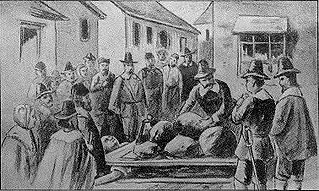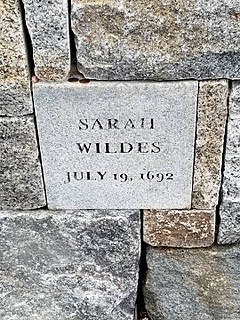
The Crucible is a 1953 play by American playwright Arthur Miller. It is a dramatized and partially fictionalized story of the Salem witch trials that took place in the Massachusetts Bay Colony during 1692–93. Miller wrote the play as an allegory for McCarthyism, when the United States government persecuted people accused of being communists. Miller was questioned by the House of Representatives' Committee on Un-American Activities in 1956 and convicted of contempt of Congress for refusing to identify others present at meetings he had attended.

The Salem witch trials were a series of hearings and prosecutions of people accused of witchcraft in colonial Massachusetts between February 1692 and May 1693. More than two hundred people were accused. Thirty were found guilty, nineteen of whom were executed by hanging. One other man, Giles Corey, was pressed to death for refusing to plead, and at least five people died in jail.
Elizabeth Parris was one of the young girls who accused other people of being witches during the Salem witch trials. The accusations made by Betty (Elizabeth) and her cousin Abigail Williams caused the direct death of 20 Salem residents: 19 were hanged, while another, Giles Corey, was pressed to death.

Giles Corey was an English-born American farmer who was accused of witchcraft along with his wife Martha Corey during the Salem witch trials. After being arrested, Corey refused to enter a plea of guilty or not guilty. He was subjected to pressing in an effort to force him to plead—the only example of such a sanction in American history—and died after three days of this torture.

Bridget Bishop was the first person executed for witchcraft during the Salem witch trials in 1692. Nineteen were hanged, and one, Giles Corey, was pressed to death. Altogether, about 200 people were tried.

Sarah Good was one of the first three women to be accused of witchcraft in the Salem witch trials, which occurred in 1692 in colonial Massachusetts.
Rebecca Blake Eames was among those accused of witchcraft during the Salem witch trials of 1692.
Mary Ann Warren was the oldest accuser during the 1692 Salem witch trials, being 18 years old when the trials began. She was a servant for John and Elizabeth Proctor. Renouncing her claims after being threatened to be hanged, she was later arrested for allegedly practicing witchcraft herself. Her life after the trials is unknown.
Sarah Osborne was a colonist in the Massachusetts Bay colony and one of the first women to be accused of witchcraft in the Salem witch trials of 1692.

Rebecca Nurse was accused of witchcraft and executed in New England during the Salem Witch Trials of 1692. She was fully exonerated less than twenty years later.
Dorothy Good was the daughter of William Good and Sarah Good. Dorothy and her mother Sarah were accused of practicing witchcraft in Salem at the beginning of the Salem witch trials in 1692. Only four years old at the time, she was interrogated by the local magistrates, confessed to being a witch and purportedly claimed she had seen her mother consorting with the devil. Mary Walcott and Ann Putnam Jr. claimed the child was deranged and repeatedly bit them as if she were an animal.
Jonathan Corwin was a New England merchant, politician, and magistrate. He is best known as one of the judges involved in the Salem witch trials of 1692, although his later work also included service as an associate justice of the Massachusetts Superior Court of Judicature, the highest court of the Province of Massachusetts Bay.
This timeline of the Salem witch trials is a quick overview of the events.
Abigail Hobbs was a girl of about 14 to 16 years old when she was arrested for witchcraft on April 18, 1692, along with Giles Corey, Mary Warren, and Bridget Bishop. Prior to living in Salem Village, she and her family had lived in Falmouth, Maine, the frontier of the Massachusetts Bay Colony, during a time when there were many attacks by the Wabanaki Native Americans. Her father William and mother, Deliverance Hobbs, were also both charged with witchcraft.
Dorcas Hoar was a widow accused of witchcraft during the Salem witch trials of 1692. She was found guilty and condemned to hang, but then confessed and with the support of several ministers, was given a temporary reprieve, after which the trials had already ended.

Sarah Wildes was wrongly convicted of witchcraft during the Salem witch trials and was executed by hanging. She maintained her innocence throughout the process, and was later exonerated. Her husband's first wife was a member of the Gould family, cousins of the Putnam family, the primary accusers, and court records document the family feuds which led to her persecution.
Abigail Faulkner, sometimes called Abigail Faulkner Sr., was an American woman accused of witchcraft during the Salem witch trials in 1692. In the frenzy that followed, Faulkner's sister Elizabeth (Dane) Johnson (1641-1722), her sister-in-law Deliverance Dane, two of her daughters, two of her nieces, and a nephew, would all be accused of witchcraft and arrested. Faulkner was convicted and sentenced to death, but her execution was delayed due to pregnancy. Before she gave birth, Faulkner was pardoned by the governor and released from prison.
Deliverance Dane was one of many women accused of witchcraft during the Salem Witch Trials. She was from Andover, Massachusetts, and due largely to the work of her father-in-law, much of the hysteria that swept through Salem was halted in Andover. Her husband, Nathaniel Dane, was the son of Rev. Francis Dane. Francis Dane was outspoken against the trials, and his two daughters Abigail Faulkner and Elizabeth Johnson were also accused of being witches. Abigail was convicted of witchcraft, but only escaped execution because she was pregnant at the time.
Mary Black was a slave of African descent in the household of Nathaniel Putnam of the Putnam family who was accused of witchcraft during the Salem witch trials. Nathaniel's nephew was Thomas Putnam, one of the primary accusers, though Nathaniel himself was skeptical and even defended Rebecca Nurse. Mary was arrested, indicted, and imprisoned, but did not go to trial, and was released by proclamation on January 21, 1693 [O.S. January 11, 1692]. She returned to Nathaniel's household after she was released, another indication of Nathaniel's view of the charges against her.






